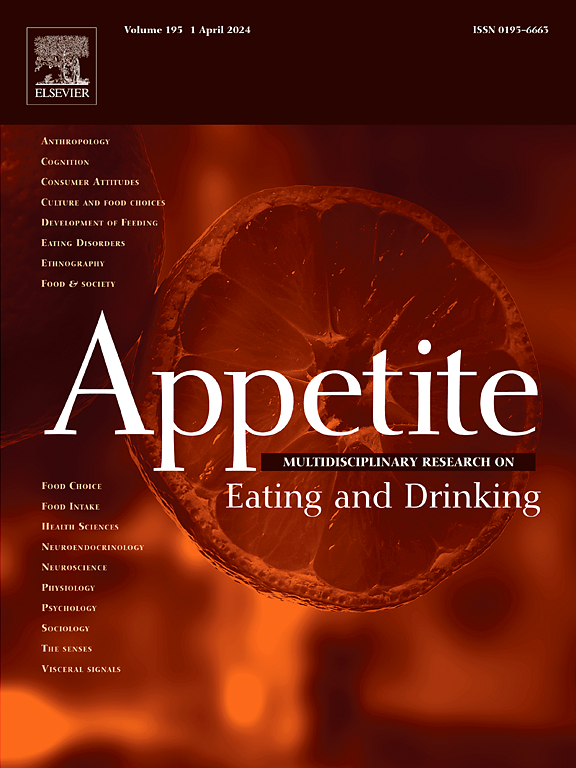Adolescent disordered eating: Associations among food insecurity, stress, and emotional eating patterns
IF 3.8
2区 医学
Q1 BEHAVIORAL SCIENCES
引用次数: 0
Abstract
Disordered eating is linked to various environmental and psychological factors, including food insecurity, stress, and emotional eating. This study investigates the associations among disordered eating, food insecurity, perceived stress, and emotional eating in adolescents, specifically focusing on parent-reported and adolescent-perceived food insecurity differences. The purpose of this study is to investigate the relationship between food insecurity, perceived stress, and emotional eating, and their impact on disordered eating. The study also examines potential interactions between stress, food insecurity, and emotional eating. 118 adolescents (11–14 years old) from low to moderate-income households participated in the University at Buffalo Eating Among Teens Study (UB-EATS), a 2-year prospective observational cohort study. Food insecurity status was analyzed through adolescent and parent/guardian survey responses. Disordered eating was measured by the Eating Disorder Examination Questionnaire (EDE-Q). Perceived stress was measured using the Perceived Stress Scale (PSS), and emotional eating was assessed using the Emotional Eating Scale (EES-C). General linear models (GLM) and linear regression analyses were conducted to evaluate the relationships among emotional eating, disordered eating, perceived stress, and food insecurity with variables such as BMI percentile, age, and sex, included as covariates. Adolescent-reported food insecurity, but not parent-reported food insecurity, was significantly associated with perceived stress, emotional eating, and disordered eating. Emotional eating was strongly associated with disordered eating, with stress moderating this relationship. These findings underscore the importance of addressing adolescent-perceived food insecurity and stress in interventions targeting disordered eating.
青少年饮食失调:食物不安全、压力和情绪化饮食模式之间的联系
饮食失调与各种环境和心理因素有关,包括食物不安全、压力和情绪化饮食。本研究调查了青少年饮食失调、食物不安全、感知压力和情绪性饮食之间的联系,特别关注父母报告的和青少年感知的食物不安全差异。本研究的目的是探讨食物不安全、感知压力和情绪性饮食之间的关系,以及它们对饮食失调的影响。该研究还调查了压力、食物不安全和情绪化饮食之间的潜在相互作用。118名来自中低收入家庭的青少年(11-14岁)参加了布法罗大学青少年饮食研究(UB-EATS),这是一项为期2年的前瞻性观察队列研究。通过青少年和家长/监护人的调查答复分析粮食不安全状况。进食障碍采用进食障碍检查问卷(ed - q)进行测量。采用感知压力量表(PSS)测量感知压力,采用情绪饮食量表(EES-C)评估情绪饮食。采用一般线性模型(GLM)和线性回归分析,以BMI百分位数、年龄和性别等变量作为协变量,评估情绪性饮食、饮食失调、感知压力和食物不安全之间的关系。青少年报告的食物不安全,而不是父母报告的食物不安全,与感知压力、情绪化饮食和饮食失调显著相关。情绪化进食与饮食失调密切相关,而压力会缓和这种关系。这些发现强调了在针对饮食失调的干预措施中解决青少年认为的粮食不安全和压力的重要性。
本文章由计算机程序翻译,如有差异,请以英文原文为准。
求助全文
约1分钟内获得全文
求助全文
来源期刊

Appetite
医学-行为科学
CiteScore
9.10
自引率
11.10%
发文量
566
审稿时长
13.4 weeks
期刊介绍:
Appetite is an international research journal specializing in cultural, social, psychological, sensory and physiological influences on the selection and intake of foods and drinks. It covers normal and disordered eating and drinking and welcomes studies of both human and non-human animal behaviour toward food. Appetite publishes research reports, reviews and commentaries. Thematic special issues appear regularly. From time to time the journal carries abstracts from professional meetings. Submissions to Appetite are expected to be based primarily on observations directly related to the selection and intake of foods and drinks; papers that are primarily focused on topics such as nutrition or obesity will not be considered unless they specifically make a novel scientific contribution to the understanding of appetite in line with the journal's aims and scope.
 求助内容:
求助内容: 应助结果提醒方式:
应助结果提醒方式:


